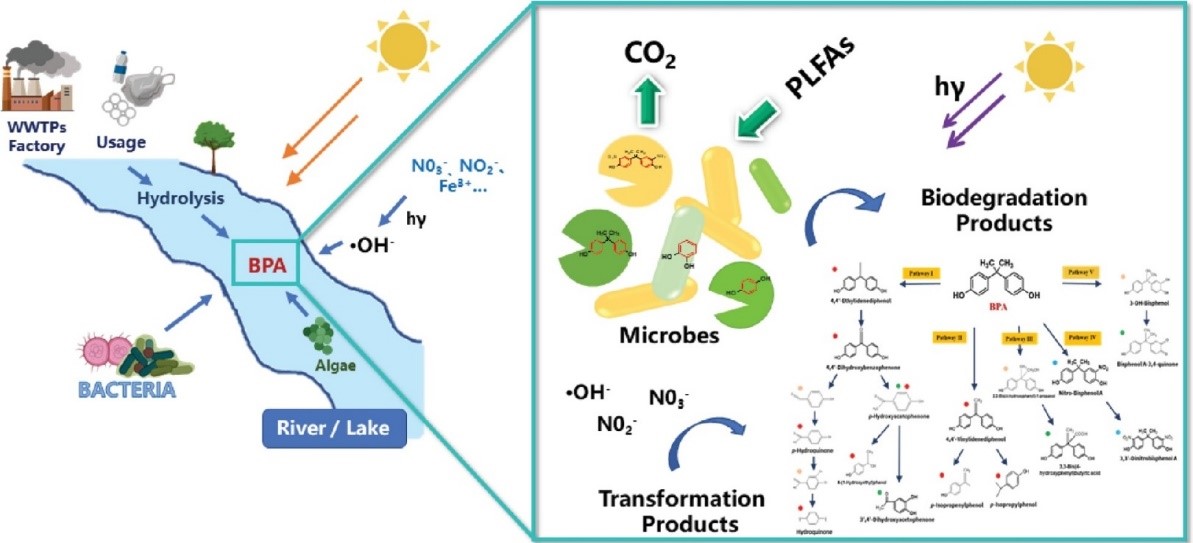Bisphenol A (BPA) is an environmental concern for its endocrine disrupting abilities. It has been used extensively, in the manufacturing of epoxy resins and polycarbonate plastics, since 1960s. Residues of BPA are ubiquitously detected in both aquatic and terrestrial environments throughout the world. Several studied have reported the occurrence as well as degradation BPA in surface water that involved variety of biotic and abiotic ecological factors viz. photolysis, hydrolysis, and biodegradation. However, these factors are always discussed in isolation, and their interaction in the attenuation of BPA have never been focused. This approach has not only resulted in limited understanding of the ecological behavior of BPA but also made it difficult to relate the transformation products identified in individual ecological factor studies. Furthermore, the trace level occurrences of BPA and its transformation products in surface water have been a limitation in the better understanding of BPA transformations mainly due to lack of sensitivity of the analytical methods.
Environmental Biotechnology Research Team from the Institute of Urban Environment, Chinese Academy of Science (IUE, CAS) has been focusing on the environmental behavior of compounds of emerging concern in the past few years. The research team conducted series of microcosm scale studies to understand the contribution of hydrolysis, direct and indirect photolysis, bacterial degradation, microbial degradation and natural attenuation that represented cumulative effect of all biotic and abiotic factors. A path analysis approach by using partial least square analysis was used to develop a structural equation model (SEM) to explain the cause and effect relationship among different factors and their contribution in the natural attenuation of BPA. Stable carbon isotope tracing by employing a combination of gas chromatography (GC-MS) and high-resolution molecular spectroscopy (HRMS) was used for qualitative and quantitative determination of potential trace level transformation products. This approach proved highly selective and sensitive in the identification of transformation products in complex river water matrix.
The SEM approach revealed that microbial degradation involving bacteria was the major factor involved in the natural attenuation of BPA, while, indirect photolysis and other microbes like algae played mediatory role in this process. A total of 14, including 3 novel transformation products were identified to propose 5 possible BPA transformation pathways. Some of the transformation products were more toxic than the parent BPA, suggesting, serious environmental implications of BPA attenuation in the river surface water. Furthermore, the bacterial assimilation of BPA was elucidated by tracing labelled carbon (13C) in phospholipid fatty acid, a major component of bacterial cell membrane.
The research team was able to develop a major understanding regarding the natural attenuation process and transformation products of BPA in surface water. This work was led by Prof. SUN Qian with major contribution from Ph.D. student LI Yan. The findings were published in the Journal of Hazardous Materials as " Bisphenol A attenuation in natural microcosm: Contribution of ecological components and identification of transformation pathways through stable isotope tracing". This work was mainly supported by the Distinguished Young Scholars of Fujian Province (2017J06013), National Science Foundation of China (41573102, 41673099), Youth Innovation Promotion Association CAS (2016280), Joint undergraduates training program of UCAS-XMU, and PIFI CAS (2017VEB0008).

Figure 1. Proposed mechanism of BPA natural attenuation in the surface water. (Image by LI Yan)

Figure 2. Comparison of GC-C-IRMS (a) and GC-MS (b) chromatograms. (Image by LI Yan)